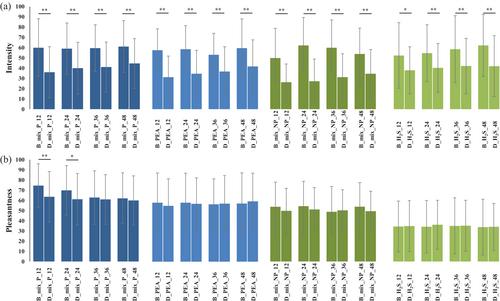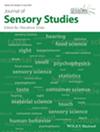Effects of desensitization on odors varying in concentration and pleasantness
Abstract
Background
Desensitization in response to repetitive odorous stimulations is a common and well-investigated process, but it has been a matter of discussion in which way this process relates to odor valence. Our goal was to investigate changes of intensity and pleasantness induced by desensitization in odors in relation to their valence and concentration.
Materials and Methods
Using air-dilution olfactometry, 30 normosmic participants received two pleasant (phenylethylalcohol [PEA], mixture of pleasant odorants [mix-P]) and two unpleasant odors (hydrogen sulfide [H2S], mixture of unpleasant odorants [mix-NP]). At the baseline (before desensitization), four different concentrations of each odor were presented randomly for 0.2 s, with 40 s inter-stimulus interval. During the desensitization procedure, the odor used was presented continuously for 15 s. Following an odor-free interval of 4 s the same odor was presented again, in the post-desensitization phase. Odor intensity and pleasantness were rated after presenting each stimulus in pre and post desensitization phases.
Results
At baseline, Mix-P was rated as pleasant and H2S was rated as unpleasant, as expected, while PEA and mix-NP were rated as slightly pleasant or neutral, respectively. For intensity, desensitization was found for all odors regardless of hedonic tone, with the effect being more pronounced with PEA and mix-NP at lower concentrations. A decrease of pleasantness/unpleasantness (“affective habituation”) was present for the two lower concentrations of the pleasant mixture, while hedonic ratings of the unpleasant odors remained largely unchanged.
Conclusions
These results suggest that, in this model, desensitization in intensity between pleasant and unpleasant odors was similar and affective habituation only occurred for the most pleasant odor.
Practical Applications
Our study unraveled the link between odor desensitization and valence considering the concentration effect, where the intensity was decreased for the relatively “neutral” odors and pleasantness was habituated only for the pleasant odor. These results help to explain individual differences in the effects of olfactory loss and provide a promising perspective for personalized treatment for olfactory loss in clinics, for instance, fast adaptation and parosmia.


 求助内容:
求助内容: 应助结果提醒方式:
应助结果提醒方式:


